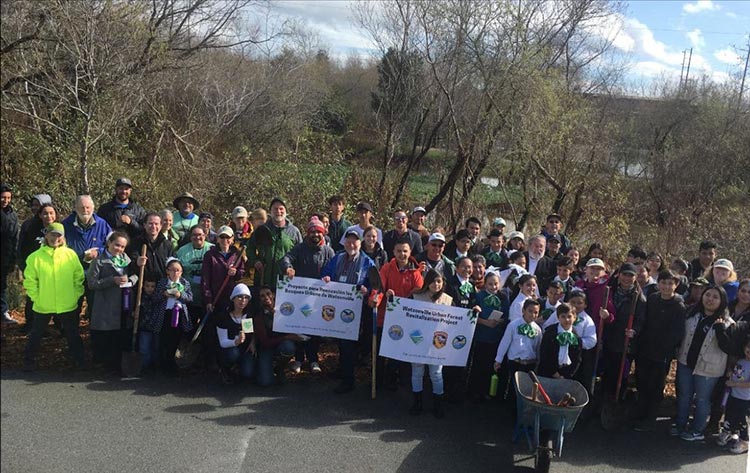Happy New Year From the Watosnville Wetlands Watch!
We reached over 4,500 students with hands-on outdoor programs about our wetlands and other environmental issues and careers while they helped to restore our watersheds. Our volunteers spent more than 8,000 hours restoring habitats, educating students and the public, and reaching thousands of people at outreach events.
This would not have been such a successful year without such a dedicated and supportive community. From all of us at the Watsonville Wetlands Watch, a big thank you for all you do and Happy New Year!
•••
Wetland Steward Yocelyn Gonzalez: Watsonville Mayor For a Day
You may remember reading about Yocelyn Gonzales in our December newsletter, where she expounded on her excitement for teaching and benefitting her community through her role as a Wetland Steward.
Last month, Yocelyn took her dedication to her community a step further by winning Watsonville’s first annual Mayor for a Day contest. Yocelyn’s experiences as a Wetland Steward, particularly with educating students, attending community events, and speaking at a City Council meeting showed her dedication to her community and helped her win this honor.
Yocelyn spent her day with Mayor Estrada learning the ropes and seeing the inner workings and processes of city government. She was also able to share some of her ideas to improve the lives of Watsonville’s citizens, including placing blue emergency light stations on the city’s thoroughfares and creating shade structures that field workers can rest under on hot days.
We sat down with Yocelyn afterwards to learn about this experience:
~~~
What did you learn from this experience?
“Being the mayor you have to make decisions that would benefit the community either now or in the long run. You need to have the ability to listen to people because there needs to be teamwork, patience, and you need to be very involved in the community.”
How do you think this experience will impact you in your education and career choices?
“It got me excited to continue my education and reminded me that I have so many opportunities, I want to either get into the medical field or education since I want to help people, save lives, or educate and it reminded me that I am not just representing myself, but my roots and race as well.”
If you were mayor and could change one thing about the environment and/or wetlands in Watsonville, what would it be?
“I would add trash cans at the bottom of Pajaro Valley High School and at the first lights from the school so there would be a reduction of trash on the sides of the bridge. Especially since it affects the environment as well as the community.”
~~~
We are incredibly proud of Yocelyn for the hard work she put into this endeavor and in our programs, and look forward to seeing all the good she’ll do in the future.
•••
Hearing their Call: California Red-Legged Frogs and Western Pond Turtles in the Watsonville Wetlands
Thursday, January 30th, 6:30-8:30 p.m.
Join biologist Gary Kittleson as he discusses his work with two of these species, the red-legged frog and the western pond turtle, and provides an update on the health of our local populations.
Taking Place at the Fitz Wetlands Educational Resource Center, 500 Harkins Slough Road at the top of Pajaro Valley High School
Admission is free but seating is limited. Please reserve your seat at http://watsonvillewetlandswatch.org
•••
Volunteer Opportunity to Assist Raptor Surveys
Watsonville Wetlands Watch is partnering with the Predatory Bird Research Group as they begin a raptor recruitment program to reduce rodent burrowing in the levy system, thereby improving flood control for the Pajaro River.
They’re working with Santa Cruz County to put up raptor recruitment structures including owl boxes and perches along a 2.5 mile stretch of the levy and are needing volunteer help monitoring for their pilot study.
If you’re interested in participating in this rodent management program by helping to survey for predatory birds and rodent burrows contact our volunteer coordinator, Noelle Fletcher at Noelle@watsonvillewetlandswatch.org.
•••
Calling All Photographers for a 2021 Calendar
We’ll be featuring a photo in every newsletter this year and in November we’ll take 13 of the highest voted photos to be featured in the calendar, which will be available for sale in our bookstore starting that month. If your photo is featured in the newsletter you’ll receive a small token of our appreciation, and photographers featured in the calendar will receive a free copy.
All photos will be given full photo credit and copyright if applicable. Send your wetland photos to noelle@watsonvillewetlandswatch.org for a chance to be featured. This month’s featured photo is by Volunteer Coordinator Noelle Fletcher of a burrowing owl (Athene cunicularia) spotted near the Fitz Wetlands Educational Resource Center in December.
•••
Plant Profile: Pajaro Manzantia
This species is unique in that it begins to bloom in December and January. The small, bell-shaped blooms provide important sustenance to bees, hummingbirds, and other pollinators when many other plants lay dormant.
Pajaro manzanita does well when planted in partial sun and partial shade and can thrive with little moisture.

